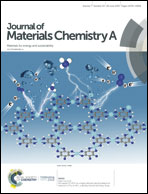A hybrid niobium-based oxide with bio-based porous carbon as an efficient electrocatalyst in photovoltaics: a general strategy for understanding the catalytic mechanism†
Abstract
Developing a high-performance catalyst and establishing a catalytic mechanism for understanding the catalytic activity are crucial to new generation photovoltaic technology. In this work, we present a feasible and general route to synthesize a bio-based porous carbon (BPC) supported ZnNb2O6 hybrid catalyst with a unique network structure, providing an effective means for electron transport between the electrode and the external circuit. Benefitting from the synergistic effect of ZnNb2O6 and BPC, a photovoltaic device assembled with the nanohybrid yields a power conversion efficiency of 8.83%, which is superior to that of pristine ZnNb2O6-based and conventional Pt-based cells (7.15% and 7.14%). Systematic electrochemical evaluations of the hybrid catalysts exhibit promising stability for practical application in photovoltaics. Contraposing the two vital functions of the counter electrode catalyst, collecting electrons and catalyzing I3− reduction, we propose a general strategy to understand the potential catalytic mechanism from the band structure and surface adsorption by using first-principles density functional theory (DFT) calculations. The theoretical investigations clearly indicate that the splendid catalytic performance originates from the zero band-gap of surface metal atoms and the surface chemical adsorption interaction between I3− and exposed metal atoms. The proposed general strategy in this work for synthesizing a hybrid material with a unique network structure and understanding the catalytic mechanism of the electrocatalyst can guide the design of expected catalytic nanohybrids applied in various energy fields.



 Please wait while we load your content...
Please wait while we load your content...